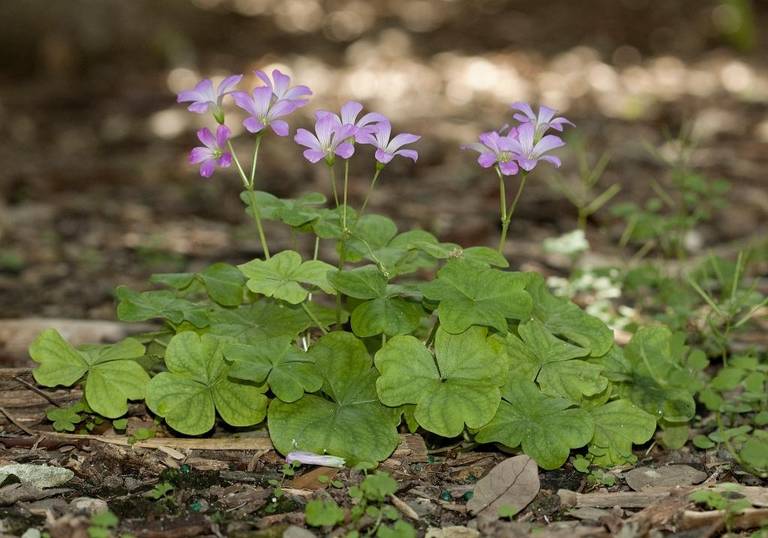A shamrock for St. Patrick’s Day: What is it, exactly?

BY KENNETH SETZER
As published in the Miami Herald, 3/10/16.
Shamrocks and clovers represent different things to different people, but are they one and the same? Like many common names, shamrock and clover turn out to refer to many different species of plants. For St. Patrick’s Day, let’s take a stab at straightening out the confusion.

A lovely weed, pink woodsorrell (Oxalis debilisi)
Every kid can point out clover. And every summer, we look for the elusive four-leaf variety. I think I found one once. Maybe it was a daydream. At any rate, these little plants are very cute with their heart-shaped leaflets, and here in the south, there are a number of them we call clover. Or shamrock. Or neither.
In quite a few publications, botanic researchers are trying to figure out what the true shamrock of Irish lore is. I’m not getting into that, mainly because whatever it is, an Irish plant probably wouldn’t last long in subtropical rain and heat.
Instead, we have several alternatives, including Oxalis stricta (aka common yellow woodsorrel or clover), listed by the USDA as native to most of the lower 48. Though considered weedy by many, this cheerful little Oxalis with small, bright yellow flowers is cheerful and edible. Grown in a pot, it tends to lose its “weed” moniker. Funny how much location matters when considering weediness. Weed or not, learn to love it, as it’s not going away.
Oxalis corniculata, also listed by the USDA as native, is very similar to O. stricta. However the leaf margins of O. corniculata are slightly hairier than those of O. stricta. Also, the foliage of O. corniculata is a bit less intensely green, with a hint of purple blush. The common yellow woodsorrell’s foliage is a more cheerful yellow-green to my eyes. O. corniculata is sometimes called creeping woodsorrell, because it spreads, creepingly, by means of stolons or “runners.”
False shamrock (Oxalis triangularis), a native of Brazil, has pointed rather than heart-shaped foliage. As its name suggests, the foliage looks like deep purple triangles. It’s a beautiful little plant, cultivated in pots and as kokedama, but I don’t imagine anyone would confuse a purple Oxalis for a shamrock. It’s gotta be green! Unlike most Oxalis, this one likes a shady area.
My favorite is probably the nonnative pink woodsorrell, Oxalis debilisi, a global weed originating in South America. It looks like the giant relative to other Oxalis, with large floppy green foliage and trumpet-shaped deep purple-pink flowers. How can you not like it? A sea of green with intense pink blooms that needs no mowing or fertilizer sounds like a nice ground cover to me — at least better than nonnative grass.
Let’s confuse things: Trifolium is a genus of plants also called clover. T. repens is the common lawn weed, the white flowers of which kids sometimes eat. Supposedly they’ve introduced themselves from Europe to the entire country, though I do not see them in South Florida. Its yellow-flowered sibling, Trifolium dubium, is also a European visitor but one that finds South Florida too warm. You might however find Trifolium pratense, the red-flowered clover, on Florida lawns.
Botanist Charles Nelson famously surveyed Irish citizens in 1988 for his book on shamrocks, and they indicated the above two Trifolium species as the best candidates, with T. dubium coming out a bit ahead. So there we have it.
I think Oxalis is still a suitable shamrock substitute. If you dig one up, you will find it growing from rhizomes like a very small hand of ginger. Separate them out and you can plant them wherever you like, provided they get enough sun. They are free, pretty, and you can observe when their three-lobed leaves fold up and go to sleep each evening. And oh, Happy St. Patrick’s Day.
